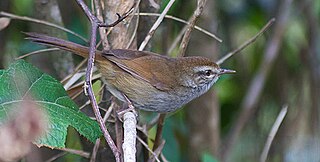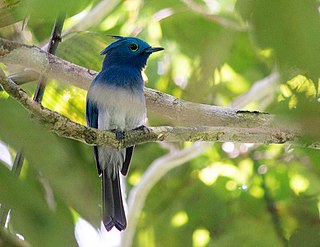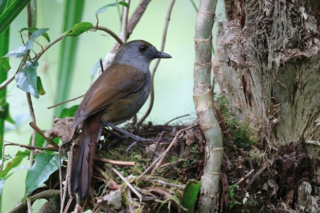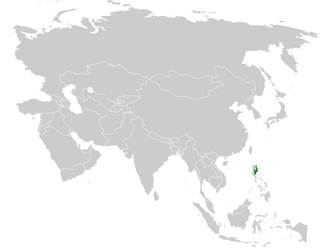
The Philippine bush warbler, also known as the Luzon bush warbler, is a species of bird in the family Cettiidae. It was formerly conspecific with the Japanese bush warbler. It is found only in the Philippines in the Cordillera Mountain Range of northern Luzon. It is found in tropical montane forest.
The flame-templed babbler is a species of bird of the family Zosteropidae, in the genus Dasycrotapha. It is one of the most remarkable and distinctive birds with its complex head markings with orange crown tufts, black ears and yellow beak and face. It is endemic to the Philippines, where it is found on the islands of Panay and Negros. Its natural habitat is tropical moist lowland forest. It is threatened by habitat loss. Along with the Negros striped babbler, it is one of the two babbler species extremely sought after by birdwatchers on Negros.

The celestial monarch is a species of bird in the family Monarchidae, and one of the most attractive of all the monarch flycatchers, with its spectacular blue crest and large greenish-yellow wattle. It is endemic to the Philippines with its extant range being in Luzon, Samar, Mindanao Tawi-Tawi and Basilan and it being possibly extinct on Negros and Sibuyan Island. It is often observed in mixed flocks with other birds such as blue fantails, rusty-crowned babblers, rufous paradise flycatchers, both short-crested monarchs and black-naped monarchs and other small forest birds. Its natural habitat is tropical moist lowland forests up to 750 masl. It is one of the most sought after birds by birdwatchers in the Philippines and in the world.

The mourning babbler, previously the short-tailed babbler, is a species of bird in the ground babbler family Pellorneidae. It is found in the Malay Peninsula, Anambas Islands, Sumatra, Banyak Islands, Batu Islands, Riau Islands, Lingga Islands and the Natuna Islands. It was formerly considered to be conspecific with the glissando babbler and the leaflitter babbler.
The Cordillera ground warbler, also known as Rabor's wren-babbler or the Luzon wren-babbler, is a species of bird currently placed in the family Locustellidae. It is endemic to the Philippines, where it is found in northwest Luzon in the foothills of the Cordillera Mountain Range. Some taxonomists continue to list the species in the Timaliidae, others in the Pellorneidae. Its natural habitat is tropical moist lowland forests. It is threatened by habitat loss.

The white-fronted tit is a species of bird in the family Paridae. It is endemic to the Philippines found in the islands of Luzon and Mindanao. Its natural habitat is tropical moist lowland forests. It is threatened by habitat loss.
The whiskered pitta is a rare species of bird in the family Pittidae. It is endemic to Luzon in the Philippines. This bird is the largest pitta in the country reaching 23 cm long and 116 g in mass. It has a brownish head, blue breast, and red belly. It has broad ash malar or "whiskers". Its natural habitat is tropical moist lowland forest and tropical moist montane forest. It is threatened by habitat loss and trapping. It is one of the most sought after birds by birdwatchers in the Philippines.

The falcated wren-babbler is a species of bird in the family Pellorneidae. It is endemic to Palawan.

The golden-crowned babbler is a species of bird in the family Zosteropidae. It is endemic to the Philippines only being found in the moist tropical forest in Northern Luzon. It is threatened by habitat loss.

The Palawan striped babbler is a species of bird in the family Zosteropidae. It is endemic to the Philippines, where it is only found in Palawan.
The Panay striped babbler is a species of bird in the family Zosteropidae and one of the most attractive birds in the country. It is endemic to the Philippines only being found on the island of Panay (Philippines). Its natural habitat is tropical moist montane forest. It is threatened by habitat loss.
The Visayan babbler, formerly conspecific with the Calabarzon babbler, is a species of bird in the family Zosteropidae. It is endemic to the Philippines. It is found on Samar, Leyte and Bohol.
The Negros striped babbler is a species of bird in the family Zosteropidae. It is endemic to Negros Island (Philippines).

The Luzon striped babbler is a species of bird in the family Zosteropidae. It is endemic to the Philippines, where it is only found in northern Luzon and in Bataan.

The chestnut-faced babbler is a species of bird in the white-eye family Zosteropidae. It is endemic to the island of Luzon in the Philippines. There are two subspecies, Z. w. whiteheadi in northern and central Luzon, and Z. w. sorsogonensis in southeastern Luzon. The species is generally found in mountain forests, generally above 1000 m. Within its range it is catholic in its choice of habitat, frequenting broadleaf forests, moist mossy forests, pine forest, open forest, scrub and human modified habitat as well.

The Bagobo babbler or Bagobo robin is a monotypic species of bird with its taxonomy undergoing numerous changes and is currently classified as Muscicapidae or an old world flycatcher. It is endemic to the Philippines only found in Mindanao.

The ashy thrush, also known as the ashy ground-thrush, is a species of bird in the family Turdidae. It is endemic to the Philippines in Luzon and Mindoro. Its natural habitats are tropical moist lowland forests and or tropical moist montane forests. It is threatened by habitat loss, and the illegal wildlife trade.

The Sierra Madre ground warbler is a species of passerine bird in the family Locustellidae. It is endemic to the island of Luzon in the Philippines, where it is found in the northeastern and eastern foothills of the Sierra Madre. Its habitat is in tropical moist lowland and the lower reaches of tropical montane forest. Along with its closest relatives, the Cordillera ground warbler and the Bicol ground warbler, it is one of the most elusive birds in the country due to its extremely shy nature. While not officially threatened, its population is said to be declining due to habitat destruction through deforestation.
Robsonius is a genus of passerine birds in the family Locustellidae. The genus was introduced by the English ornithologist Nigel J. Collar in 2006 with the Cordillera ground warbler as the type species. The name was chosen to honour the British ornithologist Craig R. Robson.













